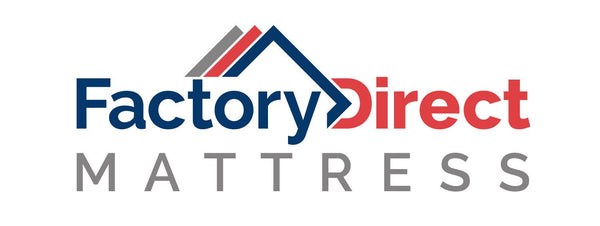The Ultimate Guide to Mattress Types: Innerspring - Hybrid - Memory Foam
Welcome to the definitive guide to mattress types, brought to you by Factory Direct Mattress in Kansas City. Choosing a new mattress can feel like a monumental task. With terms like "memory foam," "innerspring," "latex," and "hybrid" floating around, it's easy to get lost in the jargon. But understanding these core mattress types is the single most important step you can take toward finding the perfect bed for a restful night's sleep.
The Innerspring Mattress: A Timeless Classic
When you picture a traditional mattress, you're likely thinking of an innerspring. As the oldest and most familiar mattress technology, the innerspring has been the foundation of a good night's sleep for generations. Its enduring popularity is a testament to its straightforward design, affordability, and reliable support.
A Brief History of the Spring
The concept of using metal coils for support dates back to the 19th century, but it wasn't until 1871 that German inventor Heinrich Westphal first used a system of steel coils in a mattress. Before this innovation, mattresses were rudimentary bags stuffed with materials like straw, horsehair, or cotton, which offered little in the way of support and would compact over time.
Westphal's invention revolutionized the industry. The interconnected network of springs provided a level of support and durability that was previously unimaginable. This core technology, known as the Bonnell coil, became the industry standard for decades. While materials and manufacturing have advanced significantly, the fundamental principle of the innerspring mattress—a steel coil support core—remains a cornerstone of the mattress world.
How an Innerspring Mattress is Made
At its heart, an innerspring mattress is defined by its support core of steel coils. However, modern innerspring mattresses are more complex than their early predecessors.
- The Support Core: This is the main layer of springs. There are several types of coil systems used today, including Bonnell Coils, Offset Coils, Continuous Coils, and advanced Pocketed Coils which are found in modern hybrid mattresses.
- The Comfort Layer: Above the spring system lies the comfort layer. This is what provides the initial softness and cushioning, typically made from materials like fiberfill, cotton, wool, or various types of foam.
Pros and Cons of Innerspring Mattresses
Pros
- Excellent Breathability
- Strong Edge Support
- High Affordability
- Responsive and Bouncy Feel
Cons
- Limited Pressure Relief
- Noticeable Motion Transfer
- Potential for Noise Over Time
- Durability Concerns with Comfort Layers
Who is an Innerspring Mattress Best For?
- Budget-Conscious Shoppers
- Hot Sleepers
- Stomach and Back Sleepers
- Those Who Prefer a Traditional, Bouncy Feel
The Memory Foam Mattress: A Revolution in Comfort
Emerging in the 1990s, the memory foam mattress completely changed the way people thought about sleep. Its unique ability to contour to the body, relieve pressure points, and isolate motion offered a sleep experience unlike any other. Today, it remains one of the most popular mattress types, especially for those seeking deep, cradling comfort.
From Space Shuttles to Bedrooms
The story of memory foam begins not in a mattress factory, but at NASA in the 1960s. They developed a viscoelastic polyurethane foam to improve aircraft cushion safety. This "slow-springback foam" eventually found its way into medical equipment and, in the early 1990s, the first memory foam mattress was released to the public, popularizing the "bed in a box" concept for shoppers in Kansas City.
How a Memory Foam Mattress is Made
A true memory foam mattress is constructed entirely from different layers of foam:
- The Comfort Layer: The top layer of viscoelastic memory foam that provides the signature contouring and pressure relief.
- The Transition Layer: A buffer layer of slightly firmer foam to prevent sinking too deeply.
- The Support Core: A thick, high-density polyurethane foam base that provides stability and durability.
Modern memory foams often include features like gel infusions (comfort gel mattress) to improve cooling.
Pros and Cons of Memory Foam Mattresses
Pros
- Superior Pressure Relief
- Excellent Motion Isolation
- Promotes Spinal Alignment
- Completely Quiet Operation
Cons
- Can Retain Heat (less so in modern versions)
- May Cause a "Stuck" Feeling
- Potential for Initial Off-Gassing Smell
- Edge Support Can Be Lacking
Who is a Memory Foam Mattress Best For?
- Side Sleepers
- Couples (due to motion isolation)
- People with Chronic Pain
- Those Who Love a "Hugging" Feel
The Latex Mattress: Natural, Responsive Comfort
Latex mattresses offer a unique combination of responsiveness and contouring comfort, making them a popular choice for those seeking a durable, eco-friendly sleep surface. Derived from the sap of the rubber tree, latex provides a buoyant, supportive feel that is distinct from both innerspring and memory foam.
A Natural Evolution in Sleep
The use of latex foam began in the early 20th century, with the Dunlop method being patented in 1929. The later development of the Talalay process created a lighter, more consistent foam. With growing consumer interest in natural and sustainable materials, latex mattresses have surged in popularity as a premium, eco-friendly option.
Pros and Cons of Latex Mattresses
Pros
- Responsive and Buoyant Feel
- Extremely Durable and Long-Lasting
- Naturally Cooling and Breathable
- Eco-Friendly and Hypoallergenic
Cons
- High Initial Cost
- Very Heavy and Difficult to Move
- Can Be Too Firm for Some Sleepers
- Potential for Rare Latex Allergies
Who is a Latex Mattress Best For?
- Eco-Conscious Shoppers
- Hot Sleepers
- Combination Sleepers
- Those Seeking a Durable, Long-Term Investment
The Hybrid Mattress: The Best of Both Worlds
The hybrid mattress is the newest and fastest-growing category in the mattress industry. As its name suggests, a hybrid combines the best features of innerspring and foam (or latex) mattresses into one premium package. It aims to deliver the sturdy, responsive support of a coil system with the pressure-relieving comfort of foam.
The Modern Synthesis of Sleep Technology
Hybrid mattresses emerged in the 2000s to solve the drawbacks of other mattress types. By pairing an advanced pocketed coil support core with substantial comfort layers of memory foam or latex, manufacturers created a mattress that truly offered the "best of both worlds." The puffy hybrid mattress is a great example of this popular modern design.
Pros and Cons of Hybrid Mattresses
Pros
- Balanced Feel of Comfort and Support
- Excellent for Spinal Alignment
- Great for Hot Sleepers (due to coils)
- Good Motion Isolation
- Strong Edge Support
Cons
- High Price Point
- Heavy and Difficult to Move
- Some Motion Transfer (more than foam)
Who is a Hybrid Mattress Best For?
- Sleepers Who Can't Decide Between Foam and Springs
- Couples with Different Preferences
- Hot Sleepers Who Want Foam Comfort
- Suitable for All Sleeping Positions
Your Perfect Mattress Awaits in Kansas City
Understanding the four main mattress types is the key to navigating the market with confidence. At Factory Direct Mattress, we are proud to offer a wide selection of all these mattress types right here in Kansas City. We believe that an educated customer is a happy customer. Now that you're equipped with this knowledge, we invite you to visit our showroom. Lie down, test out the different feels for yourself, and let our no-pressure sleep experts help you find the perfect mattress to transform your sleep.
Shop All Mattresses



